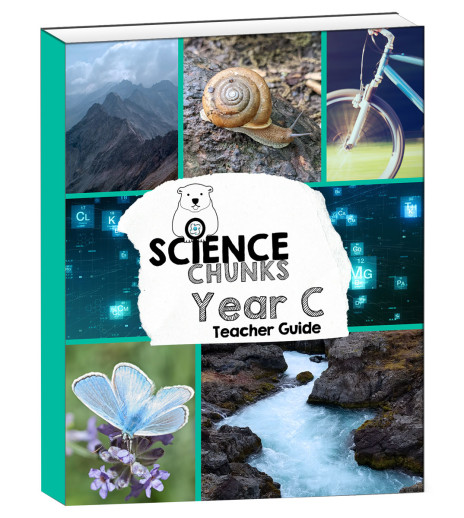We use cookies to make your experience better. To comply with the new e-Privacy directive, we need to ask for your consent to set the cookies. Learn more.
Science Chunks Year C Teacher Guide
Science Chunks - Year C Teacher Guide includes the lessons and appendices from the 7 units of year C in printed form.
Each lesson has reading assignments, vocabulary, writing assignments (both for a lapbook and a notebook), hands-on science activities, and a to-do list to check off as you work through the lesson!
Please note that the reading assignments for this year of science come from the following:
- Younger students (1st to 3rd grade) - Kingfisher Encyclopedia of Animals, DK Children’s Encyclopedia, Basher Science: The Complete Periodic Table, Basher Physics
- Older students (4th to 6th grade) - Animal! (DK and Smithsonian), Usborne Science Encyclopedia, Kingfisher Science Encyclopedia, DK Eyewitness: The Elements
- All students - Who Was Marie Curie? by Megan Stine
Covers the living and non-living world, plants and animals, invertebrates, planet earth, the periodic table, and motion and forces. Students are introduced to Marie Curie and her contributions to chemistry.
Books scheduled through the year include:
Younger students (1st to 3rd grade) – Kingfisher Encyclopedia of Animals, DK Children’s Encyclopedia, Basher Science: The Complete Periodic Table, Basher Physics.
Older students (4th to 6th grade) – Animal! (DK and Smithsonian), Usborne Science Encyclopedia, Kingfisher Science Encyclopedia, DK Eyewitness: The Elements.
All students – Who Was Marie Curie? by Megan Stine
| Product Format: | Paperback |
|---|---|
| Grades: | K-6 |
| Brand: | Elemental Science |
| ISBN: | 9781953490216 |
| Length in Inches: | 11 |
| Width in Inches: | 8.5 |
| Height in Inches: | 0.25 |
| Weight in Pounds: | 0.75 |
Be the first to review this item


It's election year, and my kid is finally old enough to understand.
election unit this year